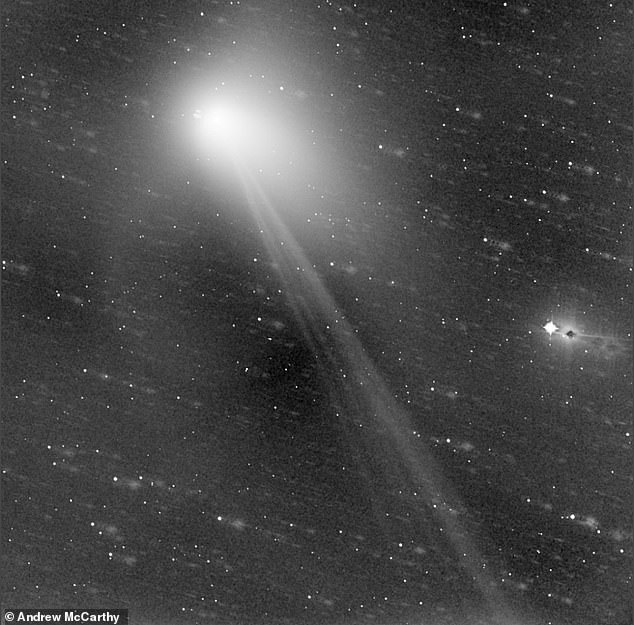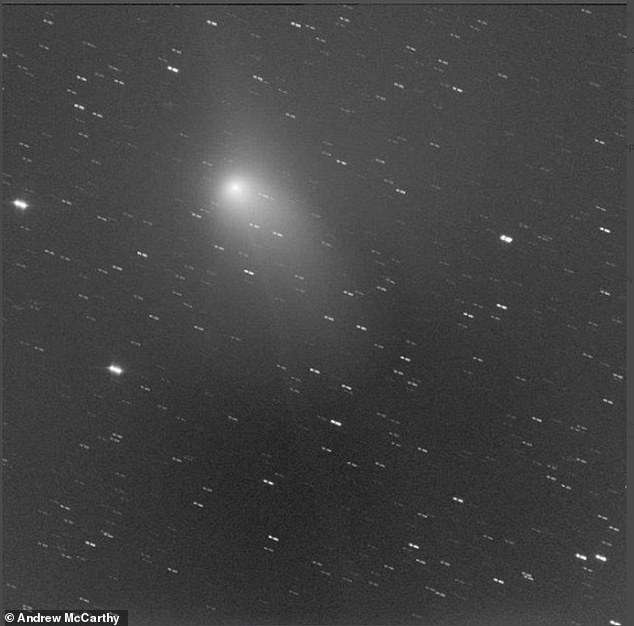Stunning image gives sneak peek at green comet passing Earth next week
>
A comet not seen since Neanderthals walked the Earth 50,000 years ago is returning in a week, but astrophotographers are getting a sneak peek at the once-in-a-generation ice ball.
Andrew McCarthy, from Arizona, snapped a stunning image of C/2022 E3 (ZTF), capturing the bright greenish coma and long, glowing tail.
Currently, E3 can only be seen with a telescope, but it will be visible to the naked eye when it reaches perigee at the start of February when it is 26 million miles away.
McCarthy told DailyMail.com that he spent an entire morning tracking the comet and the ‘result is a stack from about 45 photos captured over a period of an hour between clouds.’
Andrew McCarthy tracked the comet for hours, snapping pictures every chance he could. The final result, which is the comet’s natural colors, is a stunning image that shows its green coma and glowing tail
McCarthy continued to explain that there were many clouds in the sky the day he was tracking E3 and snapped photos every chance he got.
‘The image actually had a lot of artifacts from the clouds and being near a streetlight,’ he told DailyMail.com.
The raw image looked terrible as a result. You can see some of the artifacts from the clouds here, showing uneven patches.
‘You can also see how the stars and the comet were in different positions over that hour, which also had to be corrected (which is a very complicated procedure).’
McCarthy said he performed a lot of processing to clean up the image to get the stunning result, but the ion tail seen in the unprocessed photo ‘is accurate.’
And he told DailyMail.com the color in the image is real.
In early March, astronomers discovered Comet C/2022 E3 (ZTF) using the wide-field survey camera at the Zwicky Transient Facility.
Since then, the new long-period comet has brightened substantially and is now sweeping across the northern constellation Corona Borealis in predawn skies.
Stargazers will be able to tell the difference between the comet and surrounding stars as it will have a streaking trail of dust following it.
A glowing green coma, a cloud of gas, will be clinging around it.
This gas is formed as the comet passes close to the sun, causing its ice to change state.
Comets are known for being unpredictable, but the brightness of C/2022 E3, according to its current trend, should make it easy to spot with binoculars or a telescope.
However, those without specialist equipment should not worry, as it may even be visible to the naked eye if the skies are dark enough later this month.
However, Bryce Bolin, who discovered the comet last year, ‘secretly hope[s] it will disintegrate’ as ‘that’s where the more interesting science is.’

Currently, E3 can only be seen with a telescope , but it will be visible to the naked eye when it reaches perigee at the start of February, when it is 26 million miles away. McCarthy shared an unprocessed image of the comet

McCarthy continued to explain that there were many clouds in the sky the day he was tracking E3 and snapped photos every chance he got
He told the Boston Globe: ‘Comets are the cats of the solar system; they do whatever they want.
‘Like cats they have fluffiness. Comets have been observed to have peculiar behaviors, like fragmenting or disintegrating.
‘But there is not really a strong correlation between the distance to the sun and the kind of disintegration events that occur. It could break apart on its way in before it ever comes close to the sun, or even after.’
The NASA postdoctoral program fellow said that he and Caltech senior staff scientist Frank Masci were at the California Institute of Technology’s Palomar Observatory when artificial intelligence flagged the comet was unknown.
If the unaided eye can spot this newly discovered comet, it will be the first time since NEOWISE soared by Earth in 2020, although it won’t be anywhere near as spectacular.
